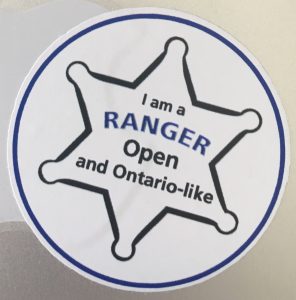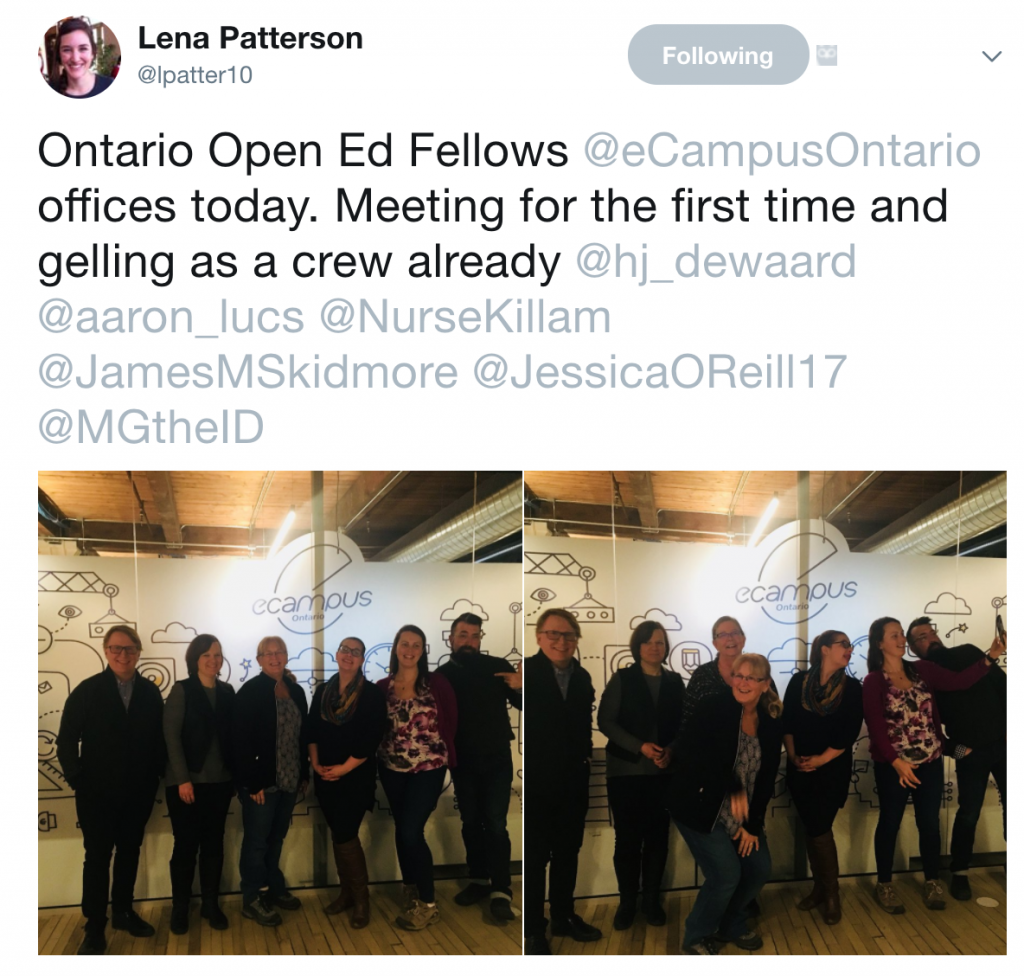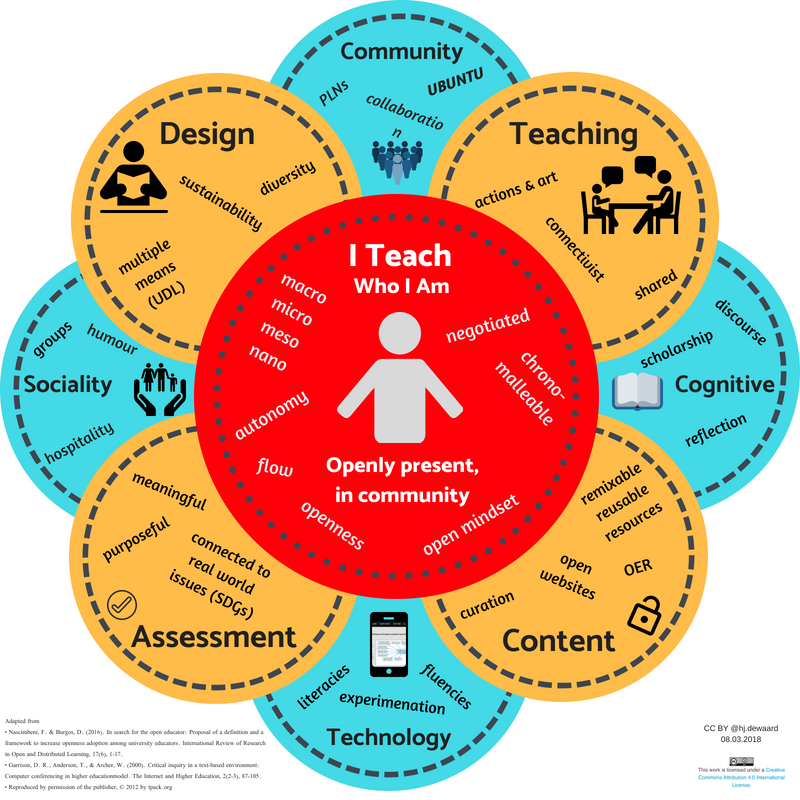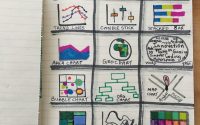Defining MY open
Defining and Refining Definitions of ‘Open’ and ‘Fellowship’
Defining my open was shaped by the application video for the OEFellows with eCampus Ontario.
My notion of “open”, in reflection of my open fellowship experiences with eCampus Ontario, has shifted through multiple meanings and multilayered understandings, as suggested by Pomerantz and Peek (2016) in Fifty Shades of Open. For this and subsequent posts reflecting on my OEFellows journey, I will play with the word open to mean (a) physically open, as in a door is open; (b) open minded, as in willing to try new things; (c) open access, as in admittance but also available for use; (d) openly transparent, as in being able to view inside; (e) philosophically open, as in willingness to share, honesty, being collaborative; and (f) free, as in open for all (Pomerantz & Peek, 2016). While “open” in education does not need to be bound by digital production, that is one constraint I will impose on my story.
As I journeyed into open fellowship with the eCampus Ontario OEFellows, the many conflicting conceptions, definitions, and visions for open education erupted. These included:
- open education resources (Bayne, Knox, & Ross, 2015; Rolfe, 2011; Weller, 2013; Wiley, Bliss, & McEwan, 2014);
- open scholarship (Veletsianos & Kimmons, 2012; Stewart, 2015; Weller, 2011);
- the open education movement (Alevizou, 2013; Bayne, Knox, & Ross, 2015; McAndrew & Farrow, 2013; Noddings & Enright, 1983; Rolfe, 2011);
- open pedagogies (Armellini & Nie, 2013; Ehlers, 2011a; Cronin & MacLaren, 2018; Nascembeni & Burgos, 2016); and
- open education practices (Paskevicius, 2017; Stagg, 2017; Veletsianos, 2015).
Exploring, Extending and Sharing
In reflection, I’ll focus on my open educational practices (OEPr) in collaboration with the OEFellows, and through eCampus Ontario projects and events.

Just as the metaphor suggests, Open Rangers in Ontario education engage in exploration. It’s therefore appropriate that my journey with eCampus Ontario began with a day to explore open education as an OEORanger (#OEORanger) , which led me to apply and become an OEFellow, to further explore the many paths into the open education landscape. In becoming an OEFellow, I opened myself to opportunities where explorations often shift elements in my
From open rangers, to open fellows. My open journey in fellowship began just over a year ago, and continues to provoke new thinking about open education.

As I began this journey I needed to find clarification and determined that my focus was in the area of open educational practices. I’ll differentiate open education practices (OEPr) from OEP which is commonly used for both open pedagogies and open practices. For me, OEPr includes more than the description proposed by Nascimbeni & Burgos (2016) that idenfities four areas of activity: (a) design, (b) content, (c) teaching, and (d) assessment. Paskevicius (2017) suggests that openness saturates all components of a teachers work, creating porous learning boundaries, while applying learning agency, and personally crediting knowledge acquisition. This conception of “open” is less like clothing to be worn or changed, and more like a skin that encompasses and open identity, and stretches with growth. These definitions step closer to my view of OEPr but are missing the elements of building a professional teaching identity, intentional equitable hospitality in networks, and responsibility toward others, thus shifting what it means to be an open educator closer to the ethos of Ubuntu, as shared in the next section.
My OEFellows webinar work with Jessica O’Reilly, Laura Killam, Marnie Seal, and Sarah Wendorf helped hone my understanding of OEPr.
I am compelled to share these moments of courageous action, of stepping out of my comfort zone, as well as the shifts from silent reflection to dramatic entanglements. I’m creating a counter-narrative to the institutional and educational stance of closed and walled spaces in which many select, or are bound, to teach and learn, in order to break from the limiting, closed, learning experiences within course learning management systems (LMS), which are found to predominate Canadian higher education spaces (Bates, T., Desbiens, B., Donovan, T., Martel, E., Mayer, D., Paul, R., Poulin, R., & Seaman, J., 2017; Lane, 2009).
Ubuntu, Connecting, and Community
“Humanity is a quality we owe to each other. We create each other and need to sustain this otherness creation. And if we belong to each other, we participate in our creations: we are because you are, and since you are, definitely I am. The ‘I am’ is not a rigid subject, but a dynamic self-constitution dependent on this otherness creation of relation and distance.” (Eze, 2010, p. 190-191)
This perception of Ubuntu imagines the dynamic self-constitution results from the OEFellows journey, from an individual perspective into one where relationships influence and shift my sense of self. This is extended by the words of Roxa and Martensson (2009) whereby “teachers allow themselves to be influenced to such an extent that they develop, or even sometimes drastically change, their personal understanding of teaching and learning” (p. 547). My self-constitution as an open educator iterates as I engage in action and conversation, as I become influenced by others.
While reflecting on what it takes to learn, teach and work within open educational landscapes within a fellowship such as the eCampus OEFellows, I’m drawn toward James Paul Gee’s (2005) conception of affinity spaces. The notion of affinity spaces includes fluidity of participation, porous boundaries of spaces for engagement, actions within multiple groups at once, involvement in global networks, focusing on interests and passions, and gaining credibility through knowledge sharing. This vision fits the OEFellows journey, since my actions in fellowship with others in the eCampus Ontario digital spaces emulates affinity groups in its fluidity, porousness, multiplicity, passion based, and knowledge sharing dynamics. In this affinity group I ‘self-constitute’ as an open educator. I am but one dot within the shifting landscape of open education in Ontario, yet my voice is one that can shift the landscape for others. (Look for my name amid the Tags Explorer animation)
CONNECTING in the OPEN
The theory of connectivism fits my image of the teaching and learning that I experience as an OEFellows within the eCampus Ontario community. Siemens (2006) states:
The act of learning … is one of creating an external network of nodes – where we connect and form information and knowledge sources. The learning happens in our heads in an internal network (neural). Learning networks can then be perceived as structures that we create in order to stay current and continually acquire, experience, create, and connect new knowledge (external). And learning networks can be perceived as structures that exist within our minds (internal) in connecting patterns of understanding (p. 29).
The four key principles of connectivism include autonomy, connectedness, diversity, and openness (Bell, 2011; Couros, 2010; Siemens, 2005; Tschofen & Mackness, 2012) as supported by emerging technologies that are shaping human cognition in the way we “create, store, and distribute knowledge” (Couros, 2010, p. 114). My connected OEFellow network and eCampus affinity groups influence my knowledge construction and how I mobilize learning, thus influencing my OEPr.
The story I started when I shared my Open Story as part of the #OpenStories global project, will continue to share my narrative.
I will also refine and redefine my conception of open.

References
Alevizou, G. (2015). From OER to MOOCs: Critical perspectives on the historical mediation trajectories of open education. International Journal of Media & Cultural Politics, 11(2), 203-224.
Bates, T., Desbiens, B., Donovan, T., Martel, E., Mayer, D., Paul, R., Poulin, R., & Seaman, J. (2017, September). Tracking online and distance education in Canadian universities and colleges: 2017. Retrieved from https://onlinelearningsurveycanada.ca/publications/
Bayne, S., Knox, J., & Ross, J. (2015) Open education: Need for a critical approach. Learning, Media, and Technology, 40(3), 247-250. doi:10.1080/17439884.2015.1065272.
Bell, F. (2011). Connectivism: It’s place in theory-informed research and innovation in technology-enabled learning. The International Review of Research in Open and Distance Learning, 12(3).
Couros, A. (2010). Developing personal learning networks for open and social learning. In G. Veletsianos (Ed.), Emerging technologies in distance education. Athabasca University Press, 109-127.
Cronin, C. (2016, May 23). #OER16: A critical turn. [blog post] http://catherinecronin.net/conferences/thoughts-on-oer16/
Cronin, C. (2017). Openness and praxis: Exploring the use of open educational practices in higher education. International Review of Research in Open and Distributed Learning, 18(5): 15-34. Retrieved from http://www.irrodl.org/index.php/irrodl/article/view/3096/4301
Eze, Michael Onyebuchi (2010). Intellectual history in contemporary South Africa. Palgrave Macmillan. ISBN 978-0-230-62299-9. pp. 190–191.
Farrow, R. (2015). Open education and critical pedagogy. Learning, Media and Technology. DOI:10.1080/17439884.2016.1113991
Gee, J. P. (2005). Semiotic social spaces and affinity spaces: From the age of mythology to today’s schools. In Beyond Communities of Practice: Language, Power and Social Context(Vol. 9780521836432, pp. 214-232). Cambridge University Press. DOI: 10.1017/CBO9780511610554.012
Jordan, K. & Weller, M. (2017). Openness and education: A beginner’s guide. Global OER Graduate Network. Retrieved from https://www.slideshare.net/GO-GN/openness-and-education-a-beginners-guide
McAndrew, P. & Farrow, R. (2013). “Open Education Research: From the Practical to the Theoretical” in R. McGreal, W. Kinuthia, and S. Marshall, (Eds.) Open Educational Resources: Innovation, Research and Practice. Commonwealth of Learning and Athabasca University, Vancouver. pp.65-78. Retrieved from https://oerknowledgecloud.org/content/open-education-research-practical-theoretical
Nascimbeni, F. (2016, February 23). The open educators factory (OEF) project. [weblog post]. Retrieved from https://education.okfn.org/the-open-educators-factory-oef-project/
Nascimbeni, F. & Burgos, D. (2016). In search for the open educator: Proposal of a definition and a framework to increase openness adoption among university educators. International Review of Research in Open and Distributed Learning, 17(6), 1-17.
Noddings, N., & Enright, D.S. (1983). The promise of open education. Theory Into Practice, 22(3), 182-189.
Paskevicius, M. (2017). Conceptualizing Open Educational Practices through the Lens of Constructive Alignment. Open Praxis, 9(2): 125-140.
Pomerantz, J. & Peek, R. (2016). Fifty shades of open. First Monday, 21(5). Retrieved from http://firstmonday.org/article/view/6360/5460
Rolfe, V. (2011). Open educational resources: Staff attitudes and awareness. Research in Learning Technology, 20: 14395. doi: 10.3402/rlt.v20i0/14395
Ross, J. & Collier, A. (2016). Complexity, mess and not-yetness: Teaching online with emerging technologies. In G. Veletsianos (Ed.), Emergence and innovation in digital learning. Retrieved from http://www.veletsianos.com/2016/06/14/complexity-mess-not-yetness/
Siemens, G. (2005). Connectivism: A learning theory for the digital age. Retrieved July 27, 2018 from http://www.elearnspace.org/Articles/connectivism.htm
Siemens, G. (2006). Knowing knowledge. Retrieved July 27, 2018 from http://www.elearnspace.org/KnowingKnowledge_LowRes.pdf
Stagg, A. (2017). The ecology of the open practitioner: A conceptual framework for open research. Open Praxis 9(4), 363-374.
Stewart, B. (2015). In abundance: Networked participatory practice as scholarship. The International Review of Research in Open and Distributed Learning, 16(3).
The Cape Town Open Education Declaration (2007). Retrieved from http://www.capetowndeclaration.org/read-the-declaration
Tschofen, C., & Mackness, J. (2012). Connectivism and dimensions of individual experience. The International Review Of Research In Open And Distributed Learning, 13(1), 124-143. doi:http://dx.doi.org/10.19173/irrodl.v13i1.1143
Veletsianos, G. & Kimmons, R. (2012). Assumptions and challenges of open scholarship. The International Review of Research in Open and Distance Learning, 13(4), 166-189.
Veletsianos, G. (2015). A case study of scholars’ open and sharing practices. Open Praxis, 7(3), 199-209.
Weller, M. (2011). The Digital Scholar: How Technology is Transforming Scholarly Practice. London: Bloomsbury.
Weller, M. (2013). Editorial: The Battle for Open. Journal of Interactive Media in Education, OER 2013 Special Issue. http://jime.open.ac.uk/jime/article/view/2013-15
Weller, M., de los Arcos, B., Farrow, R., Pitt, B., & McAndrew, P. (2015). The Impact of OER on Teaching and Learning Practice. Open Praxis, 7(4), 351-361.doi:10.5944/openpraxis.7.4.227
Wiley, D., Bliss, T. J., & McEwan, M. (2014). Open educational resources: A review of the literature. In Spector, J., Merrill, M., Elen, J., & Bishop, M. (Eds.), The handbook of research on educational communications and technology. New York, NY: Springer.
Wiley, D. (2016, March 16). ‘Open’ Educational Resources vs ‘Open’ Pedagogy: Why Meanings Matter. [weblog post]. Retrieved from http://opencontent.org/blog/archives/4496

